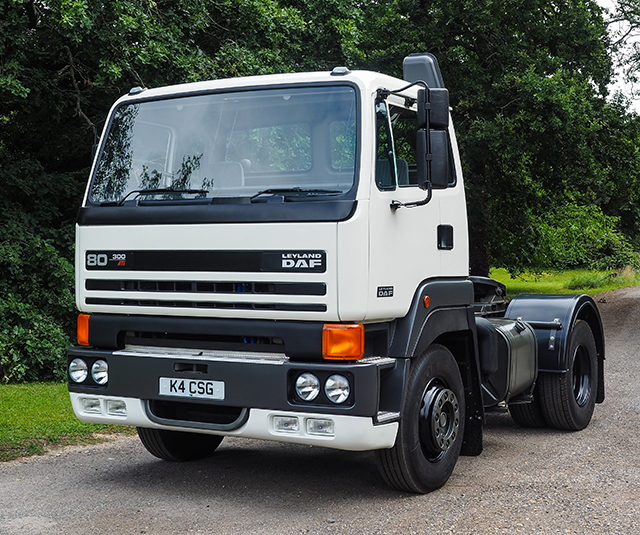
Though only a little over 25 years old, Gary Dwyer’s Leyland DAF FT80.300 is already likely to be a unique survivor. It’s also been the subject of a prize-winning restoration. Peter Simpson finds out more.
As photographer Martyn and yours truly approached Gary Dwyer’s storage facility ‘somewhere in Sussex’ for this month’s main feature photoshoot, we both had a definite feeling of deja vu. There was a good reason for that. Back in 2000, I was Publisher/Managing Editor of Bus & Coach Preservation magazine – then a fairly new title – and Martyn and I were down there to photograph and test-drive a former East Kent AEC Reliance dual-purpose bus/coach.
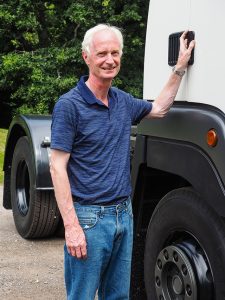
Fast-forward 19 years, and Gary still owns that Reliance, but it shares garage space with the Leyland DAF 80 Series featured here. He also still owns the AEC Mandator tractor unit he had then (and which has featured previously in CVC), along with a lovely BMC J4 van and three Leyland lorries under or awaiting restoration. These comprise a 1988 Leyland Roadtrain with a Rolls-Royce Eagle 350 diesel engine, a Leyland marathon TL12 and a 500-engined Leyland Buffalo.
So quite a collection. His most recent project to hit the road, however, was this Leyland DAF FT80.300; a lorry which, despite being one of the most recent projects in Classic & Vintage Commercials, might well already be a rare survivor in the UK. We’ll come back to that later. First, a little model history.
Developed from the Roadtrain
The Leyland DAF 80 Series was produced for just three years from 1990 to 1993. Developed from the Roadtrain after Leyland and DAF merged in 1987, it used standard DAF driveline units rather than the proprietary units fitted by Leyland. That, though, isn’t the whole story in this case as the 300 in FT80.300 refers to power output of 300bhp which equates to 222 kW, hence the DAF nomenclature of WS222 for the 11.6 litre engine. The WS engine is a DAF development of Leyland’s famous 680, which they had originally made under licence from Leyland. The 80 Series was also available with a 330bhp engine which used the WS242 engine.
The ZF 16S150 16 speed Ecosplit – as found on Gary’s lorry – was the standard gearbox and was more suited to fleet operations as it is a synchromesh unit. However, the older Eaton Twin-Splitter constant mesh gearbox that was used in the Roadtrain remained available as an option. The rear axle was the DAF 1346 unit used in their other tractor units.
The 80 Series was notable as it was the first UK tractor unit to have factory-fitted Category 1 ABS, anticipating the introduction of legislation requiring all vehicles to have ABS. This was supplied by Grau Girling. The cab was facelifted with a new grille panel in incorporating DAF’s corporate-design three horizontal bars which was made from plastic, the Roadtrain’s front panel having been aluminium. The interior was relatively unchanged apart from changing to blue trim in common with DAFs 95 Series. Front and corner panels were also changed to plastic from steel. Variations included a 6×2 twin steer version which was popular with oil companies, along with a sleeper cab rather than the day-cab on Gary’s example. All 80 Series lorries were made in the UK, at the Leyland plant in Lancashire.
Cleaning up
Gary’s 80 Series is a fairly late example, being first registered on January 1 1993. Supplied through Southampton Leyland DAF dealership Adams Morey, the first owner was the Cleansing Services Group (hence the registration) and it was originally specified with a factory-option red cab though this had ‘reverted’ to standard white by the time Gary bought it in 2012. Gary isn’t 100% about what contracts Cleansing Services Group used the vehicle for, but giving were it was based and having seen a photo of it in CSG ownership towing a tanker which clearly wasn’t a fuel tanker, he suspects it may have been something to do with transport of liquid waste from and/or ‘turning around’ shipping.

On disposal from Cleansing Services Group, the lorry went back to the supplying dealer – in part-exchange perhaps – but rather being resold, it was retained for a while before being used by a company specialising in the collection and delivery of trailers, including taking them for MoT. Then, in 2007, it went to Allied Driving Schools of Salisbury for driver training where it stayed until October 2012 when Gary, along with Paul Richman (now living in New Zealand), bought it via an eBay online auction. It came with a box-trailer but unfortunately that was destroyed when a fire broke out in the yard where it was stored. The tractor, fortunately, was not attached at the time and survived.
The restoration
When acquired, K4CSG was in reasonable condition – up and running, MoT’d and pretty presentable for its age. It seemed to need tidying and ongoing improvement rather than a full-blown rebuild, and the plan was to do this, and also take it to a few shows as a bit of light-relief from the more in-depth Roadtrain restoration which would continue alongside it. In the event, however, the 80 kind-of took over as the main project.
As mentioned earlier, the cab colour was changed from red to white at some time. Some cab repairs were carried out at the same time including many of the common trouble spots. In particular, the wheelarches and the area just below the windows in the rear panels had been repaired – and repaired well – meaning no work was needed here. A small amount of corrosion was, however, cut out from under the side window on the driver’s side and replaced with fresh metal, and some light corrosion in the windscreen surround was “caught before it got too far” and cured by thorough rubbing-down and rust treatment. The front cab crossmember behind the radiator grille also required some localised metalwork.
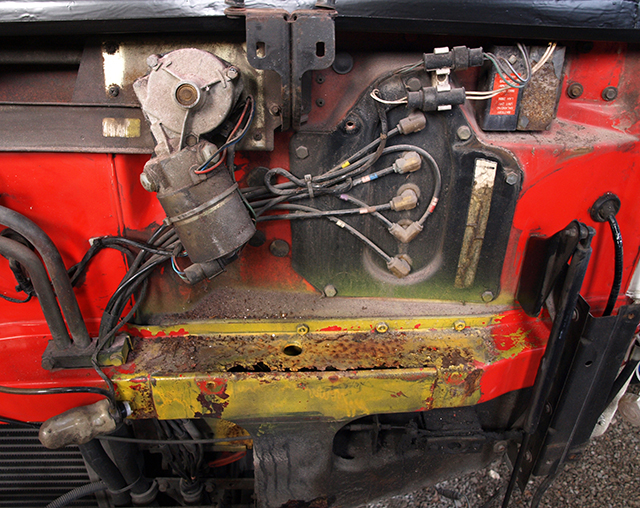
Gary then repainted the cab himself using single-pack acrylic paint which seemed to go on well enough. He then polished it up in September and thought little more of it. However when he went back to it the following spring, he discovered, to his horror, that the paint had started to ‘react’ and, if looked at from a particular angle, was crazed all over. After taking advice, he concluded that the only way out was going to be to rub it all off and, basically, start again. He was, however, uncertain what had caused the problem, though he suspected the conditions in which he’d worked.
Accordingly, Gary stripped all the paint that he had just applied. Then, given his uncertainty about the problem’s cause, he decided to play it safe and have the second cab paint done professionally. Mick Gould Commercials in Flimwell were chosen because of their reputation and because they had the means to collect and return the vehicle. As expected, they did a first-class job. DAF Brilliant White has been used to represent the standard factory finish.
Blast that chassis
Prior to painting the cab, work had also been ongoing on the chassis. After stripping, this was blasted “in a field over the road” by a mobile operator. While the main frame had only surface corrosion, numerous holes were revealed in the air tanks which had to be renewed. Gary also had to make up a new battery tray, the original being badly corroded. The fuel tank was non-original (a Scania item) but fortunately Gary had a correct replacement – acquired for the Roadtrain – in stock. Gary repainted the chassis himself, but rather than using a standard paint, he went for Epoxymastic, made in Spalding, Lincolnshire by Rustbuster, who were able to supply it in a standard RAL colour close to the correct DAF chassis grey.
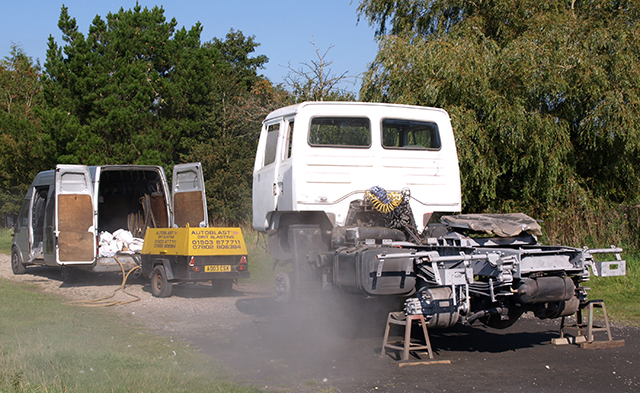
Reassembly was relatively straightforward. All rubber hoses were replaced with silicone items; Gary says that some of the original rubbers had hardened “unbelievably” and needed cutting off. The engine noise shields – fitted to meet drive-by noise regulations – both needed to be renewed as one was in very poor condition the other missing.

Gary’s aim was to be finished in time for the 2017 Leyland Gathering at Shuttleworth, but while he succeeded in getting the lorry completed, there was a problem; it needed an MoT and no-one locally had any test-slots available for ages; at the time there was a massive shortage of Authorised Testing Facilities in Sussex.
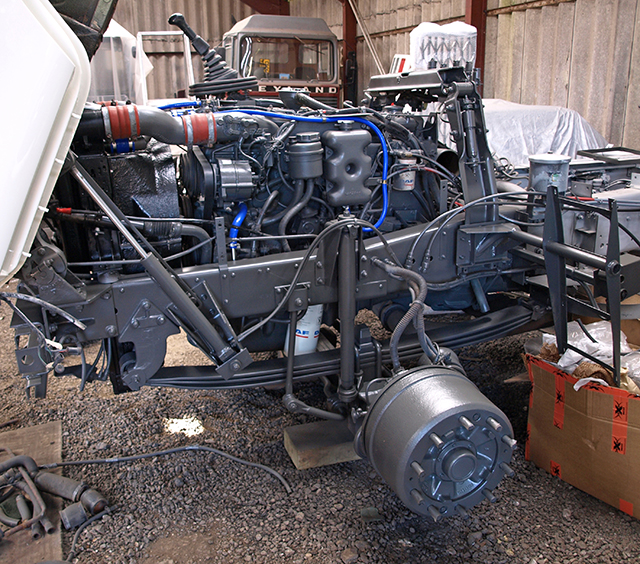
In fact, the only place that could offer a slot was an ATF in Boston, Lincolnshire, so Gary arranged an appointment there, the idea being that he could drive up, get the lorry tested just in time for the rally. However, the ATF in question didn’t have a suitable trailer for the loaded brake test. As often happens in cases like this however, the lorry enthusiasts ‘fraternity’ came to the rescue, and Kevin Dennis (who is based close by) loaned a suitable trailer and delivered it to the ATF. The lorry passed without issue, Gary then taxed it and made it to the rally.
Teething troubles
His second show of 2017 also involved a trip to the midlands – the Retro Truck Show at Gaydon. Unfortunately, however, a problem occurred on the way back from that when an oil leak developed from the fan drive idler on the front of the engine. New seals cured this and at the same time Gary changed the crankshaft seal; a job made much harder by difficulty removing the crank nose adaptor because it was far from obvious how this attached. At this point Gary didn’t have a workshop manual, but he does now….
A power steering leak also emerged shortly after the lorry returned to the road and was tracked down to original – and ‘no longer available’ steel pipes having been replaced with flexible ones; Gary made his own replacements and found a company in Sheffield that was able to form the ends.
One part of the project which caused a lot more trouble than Gary was expecting was getting the original analogue tachograph refurbished. These are now pretty-much obsolete for vehicles in commercial use, but many preserved vehicles have them, and consequently there aren’t, it seems, many places that can still overhaul them. In Gary’s case, however, an analogue tachograph was the original fitting so was needed.
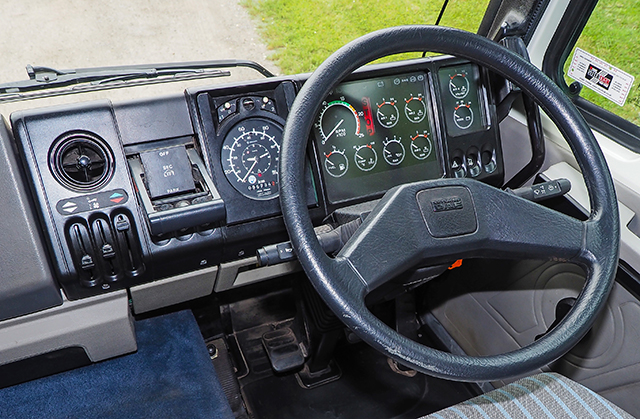
Gary found someone to give his the rebuild that it seemed to need, but it had to go back to the supplier twice times before it was right. The first time it had a broken glass which wasn’t broken when it was originally sent, the second time the clock was noisy. Even more frustratingly – but not in any way the tachograph company’s fault – an additional problem found when recalibrating the unit turned out to be nothing to do with the tachograph but faulty wiring and a defective road-speed sensor.
Due to the various teething troubles and other commitments, Gary didn’t use the lorry much in 2018. In 2019, however, it made its HCVS London to Brighton debut and picked up a fully-deserved second in class award. It also got to the Leyland Society rally at the newly-refurbished British Commercial Vehicle Museum in Leyland. It should perhaps be noted in this context that as well as attending the Leyland Society annual rally, Gary is the event’s organiser as well as being the Society’s Chairman and Treasurer!
Conclusions
As mentioned earlier, the Leyland DAF 80 Series is now surprisingly rare in the UK. In fact, Gary doesn’t know of any surviving 6×2 tractor units in the UK, though there is one 4×2.Why? Clearly the three-year production run is a consideration. However the main issue is that the life-cycle of a typical lorry has changed since the 1970s, and the Leyland DAF 80 is, perhaps an early example of the current approach, and something restorers might need to get used to.

Once upon a time, a lorry would be run for as long as it was viable for the owner/operator to do so, but as it got older and needed more work, the effective cost of replacement parts came down thanks to a good supply of secondhand parts from similar lorries that were being broken.
Nowadays, however, though there are more lorries on the road, their average age is much lower. Most haulage work is in the hands of big companies who rather than buying lorries, lease them. Then, because so much of the overall parc is new, there’s less demand domestically for used lorries, and most end up being sold to developing economies where demand is greater.
That is likely to have happened to most Leyland-DAF 80s – though here the demand was as much for the DAF engines which, being Leyland-derived, were relatively easy to substitute for Leyland units. It is, though, why they’ve all-but disappeared – Gary’s has remained here due to a fairly unusual ownership pattern – relatively low mileage first owner, then internal use by a dealership, then a driving school.
I have a feeling that in future it is lorries like this that we will need to be looking out for to preserve, rather than work out and derelict wrecks with trees growing through them…
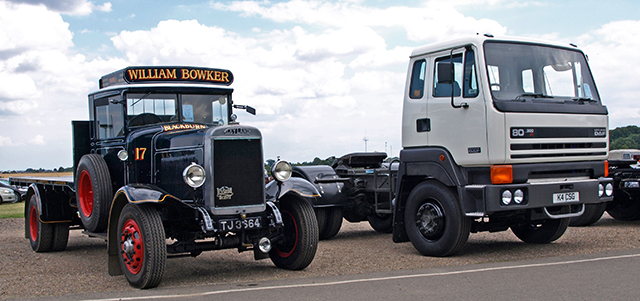
To subscribe to Classic & Vintage Commercials magazine, click here

